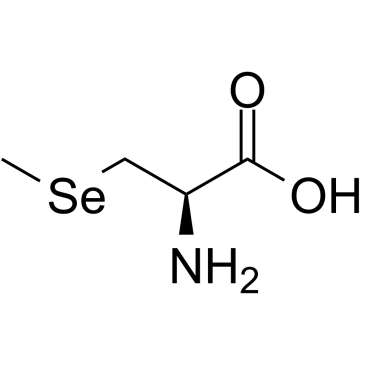| Cas No.: | 26046-90-2 |
| SMILES: | C[Se]C[C@@H](C(=O)O)N |
| Formula: | C4H9NO2Se |
| M.Wt: | 182.08 |
| Purity: | >98% |
| Sotrage: | 2 years -20°C Powder, 2 weeks 4°C in DMSO, 6 months -80°C in DMSO |
| Description: | Se-Methylselenocysteine, a precursor of Methylselenol, has potent cancer chemopreventive activity and anti-oxidant activity. Se-Methylselenocysteine is orally bioavailable, and induces apoptosis[1][2]. |
| In Vivo: | Se-Methylselenocysteine (0.2 mg/mouse; p.o.; daily for 14 days) potentiates the antitumour activity of CDDP and Cyclophosphamide in nude mice bearing human FaDu and A253 head and neck xenografts[2]. Alzheimer's disease (AD) mice are treats with Se-Methylselenocysteine (0.75 mg/kg BW per day) in their drinking water for 10 months. Se-Methylselenocysteine reduces oxidative stress and neuro-inflammation; Se-Methylselenocysteine modulates the distribution and levels of several metal ions; Se-Methylselenocysteine decreases amyloid-β peptide (Aβ) generation by inhibiting the expression of its precursor protein APP and β-secretase (BACE1), and attenuates tau hyperphosphorylation and neurofibrillary tangles (NFT) formation via promoting protein phosphatase 2A (PP2A) activity, thereby preserving synaptic proteins and neuron activities and finally improving spatial learning and memory deficits in AD model mice[3]. Animal Model: Female athymic nude mice (bearing human A253 and FaDu squamous cell carcinoma xenografts)[2] Dosage: 0.2 mg/mouse Administration: p.o.; daily for 14 days (7 days before and 7 days after Cyclophosphamide or CDDP in a total of 14 days) Result: |
| In Vitro: | Se-Methylselenocysteine (100-400 μM; 3 days) induces apoptosis in SKOV-33 cells[1]. Se-Methylselenocysteine (100-400 μM; 3 days) induces caspase-3 mediated apoptosis[1]. Apoptosis Analysis[1] Cell Line: SKOV-3 cells Concentration: 100, 200, 400 μM Incubation Time: 3 days Result: Resulted in a markedly increased accumulation of Sub-G1 phase, which occurred in both SeMSC concentration and culture time-dependent. Western Blot Analysis[1] Cell Line: SKOV-3 cells Concentration: 100, 200, 400 μM Incubation Time: 3 days Result: Resulted in a decrease in the expression of the 32 kDa form of procaspase-3. |
| References: | [1]. Yeo JK, et al. Se-methylselenocysteine induces apoptosis through caspase activation and Bax cleavage mediated by calpain in SKOV-3 ovarian cancer cells. Cancer Lett. 2002 Aug 8;182(1):83-92. [2]. Cao S, et al. Se-methylselenocysteine offers selective protection against toxicity and potentiates the antitumour activity of anticancer drugs in preclinical animal models. Br J Cancer. 2014 Apr 2;110(7):1733-43. [3]. Xie Y, et al. Se-Methylselenocysteine Ameliorates Neuropathology and Cognitive Deficits by Attenuating Oxidative Stress and Metal Dyshomeostasis in Alzheimer Model Mice. Mol Nutr Food Res. 2018 Jun;62(12):e1800107. |

 DC Chemicals' products qualify for U.S. tariff exemptions. We guarantee no price increases due to customs duties and maintain stable supply, continuing to deliver reliable research solutions to our American clients.
DC Chemicals' products qualify for U.S. tariff exemptions. We guarantee no price increases due to customs duties and maintain stable supply, continuing to deliver reliable research solutions to our American clients.





















